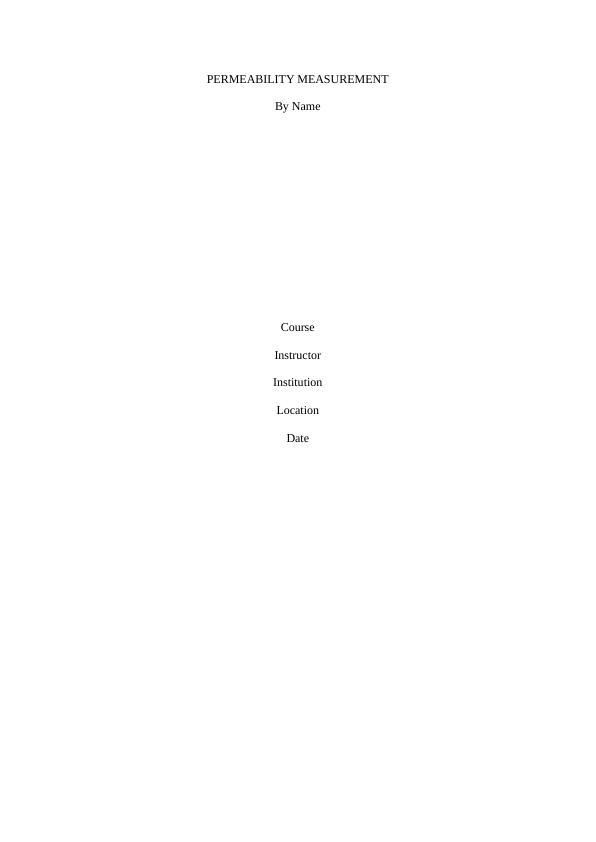Permeability Measurement
Added on 2022-10-18
10 Pages1673 Words91 Views
PERMEABILITY MEASUREMENT
By Name
Course
Instructor
Institution
Location
Date
By Name
Course
Instructor
Institution
Location
Date

Introduction
Permeability is a fundamental reservoir rock property and is extremely important for
the reservoir engineers to determine during exploration of a well and obtain flow
characteristics of the reservoir. Permeability is ability of rock to conduct fluid. Higher
permeability means higher fluid flow in porous medium (Zimmermann et al., 2019, p.
501). Higher permeability means more effective (faster) recovery of Hydrocarbons.
Henry Darcy was a French engineer who formulated Darcy law based on the results of
the experiment on the flow of water through beds of sands, forming the basis of
hydrogeology. He was established that the flow rate is given by the equation below:
qα (h2−h 1)
L
OR
q= K (h 2−h1)
L
Where q = the volume of water crossing unit area in unit time.
L = the thickness of the sand.
h1 and h2 = The heights, above reference level, of the water in meters above and
below the sand respectively.
K = A factor of proportionality
This relationship evolved into what became as known as Darcy's law and has been
modified to the following:
q= K∗A∗∆ P
μL
Permeability is a fundamental reservoir rock property and is extremely important for
the reservoir engineers to determine during exploration of a well and obtain flow
characteristics of the reservoir. Permeability is ability of rock to conduct fluid. Higher
permeability means higher fluid flow in porous medium (Zimmermann et al., 2019, p.
501). Higher permeability means more effective (faster) recovery of Hydrocarbons.
Henry Darcy was a French engineer who formulated Darcy law based on the results of
the experiment on the flow of water through beds of sands, forming the basis of
hydrogeology. He was established that the flow rate is given by the equation below:
qα (h2−h 1)
L
OR
q= K (h 2−h1)
L
Where q = the volume of water crossing unit area in unit time.
L = the thickness of the sand.
h1 and h2 = The heights, above reference level, of the water in meters above and
below the sand respectively.
K = A factor of proportionality
This relationship evolved into what became as known as Darcy's law and has been
modified to the following:
q= K∗A∗∆ P
μL

Where:
q = flow rate of liquid cc/sec.
K = Permeability in Darcies.
A = Cross – sectional area of the core sample sq.cm.
∆ P = Differential pressure in bar.
L = Length of the core sample.
μ = Viscosity of flowing liquid, Centipoise.
Objective
To obtain the permeability of core samples by flowing gases through them and also
determine the "slip" or "Klinkenberg effect" by utilizing data from gas permeability
measurements.
Theory
Permeability of a rock defines a measure of the extent of ease of convection of fluids
through a rock and is determinable by a flow experiment. The flow rate of water flow
was determined by Henry Darcy in 1856 through a sand filter which may be described
using the equation
Q=KA/L (h1-h2)
Where Q is the volumetric flow rate through sand pack has a cross section area A and
length L with h1 and h2 being the hydrostatic heads at inlet and outlet of sand pack
respectively and K is a proportionality constant. These experiments were however
q = flow rate of liquid cc/sec.
K = Permeability in Darcies.
A = Cross – sectional area of the core sample sq.cm.
∆ P = Differential pressure in bar.
L = Length of the core sample.
μ = Viscosity of flowing liquid, Centipoise.
Objective
To obtain the permeability of core samples by flowing gases through them and also
determine the "slip" or "Klinkenberg effect" by utilizing data from gas permeability
measurements.
Theory
Permeability of a rock defines a measure of the extent of ease of convection of fluids
through a rock and is determinable by a flow experiment. The flow rate of water flow
was determined by Henry Darcy in 1856 through a sand filter which may be described
using the equation
Q=KA/L (h1-h2)
Where Q is the volumetric flow rate through sand pack has a cross section area A and
length L with h1 and h2 being the hydrostatic heads at inlet and outlet of sand pack
respectively and K is a proportionality constant. These experiments were however

End of preview
Want to access all the pages? Upload your documents or become a member.
Related Documents
Importance of Relative Permeability - PDFlg...
|3
|1173
|189
